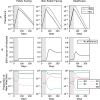Impact of essential workers in the context of social distancing for epidemic control
- PMID: 34347855
- PMCID: PMC8336873
- DOI: 10.1371/journal.pone.0255680
Impact of essential workers in the context of social distancing for epidemic control
Abstract
New emerging infectious diseases are identified every year, a subset of which become global pandemics like COVID-19. In the case of COVID-19, many governments have responded to the ongoing pandemic by imposing social policies that restrict contacts outside of the home, resulting in a large fraction of the workforce either working from home or not working. To ensure essential services, however, a substantial number of workers are not subject to these limitations, and maintain many of their pre-intervention contacts. To explore how contacts among such "essential" workers, and between essential workers and the rest of the population, impact disease risk and the effectiveness of pandemic control, we evaluated several mathematical models of essential worker contacts within a standard epidemiology framework. The models were designed to correspond to key characteristics of cashiers, factory employees, and healthcare workers. We find in all three models that essential workers are at substantially elevated risk of infection compared to the rest of the population, as has been documented, and that increasing the numbers of essential workers necessitates the imposition of more stringent controls on contacts among the rest of the population to manage the pandemic. Importantly, however, different archetypes of essential workers differ in both their individual probability of infection and impact on the broader pandemic dynamics, highlighting the need to understand and target intervention for the specific risks faced by different groups of essential workers. These findings, especially in light of the massive human costs of the current COVID-19 pandemic, indicate that contingency plans for future epidemics should account for the impacts of essential workers on disease spread.
Conflict of interest statement
The authors have declared that no competing interests exist.
Figures




References
-
- Organization, World Health. The world health report 2007: global public security in the 21st century: a safer future. World Health Organization; 2007. Available: https://www.who.int/whr/2007/whr07_en.pdf
-
- Consultation WT. Public health measures during the influenza A(H1N1)2009 pandemic. World Health Organization; 2010. Oct. Available: https://apps.who.int/iris/bitstream/handle/10665/70747/WHO_HSE_GIP_ITP_2...
Publication types
MeSH terms
LinkOut - more resources
Full Text Sources
Medical

